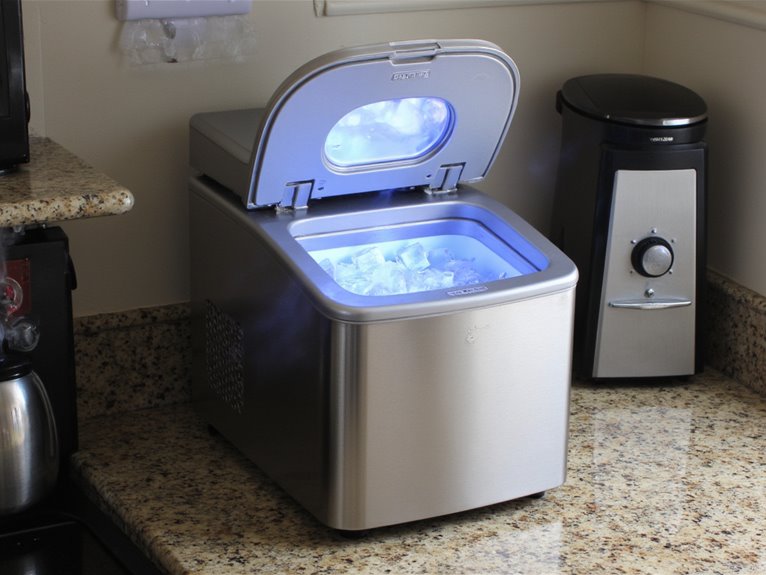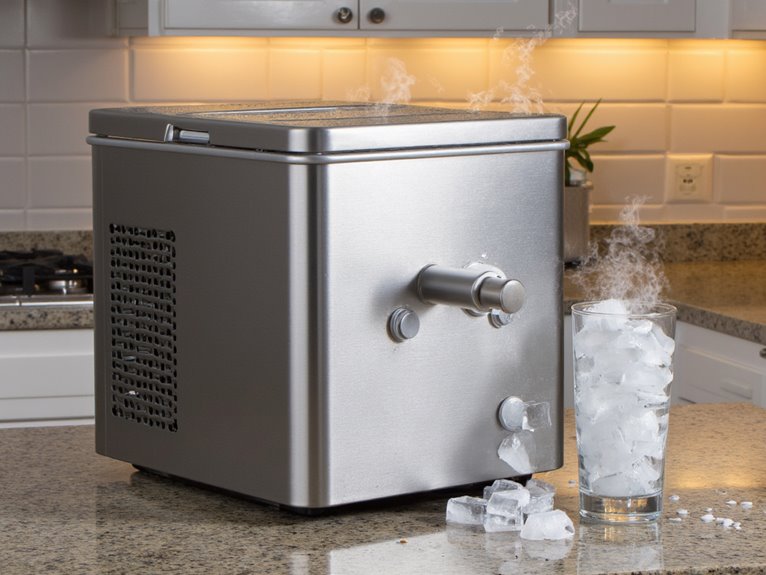The Pros and Cons of Countertop Ice Makers for Home Use
Countertop ice makers offer impressive speed, producing fresh ice in 6-15 minutes and generating up to 26 pounds daily, while consuming only 120-170 watts compared to refrigerators exceeding 300 watts. You’ll enjoy plug-and-play convenience in a compact 15-inch footprint weighing under 20 pounds. However, you’ll face storage limitations of just 2-6 pounds, requiring regular cleaning every 3-6 months, and initial costs ranging from $80-$2,000. Understanding these trade-offs helps determine whether these efficient appliances suit your specific needs.
We are supported by our audience. When you purchase through links on our site, we may earn an affiliate commission, at no extra cost for you. Learn more. Last update on 31st December 2025 / Images from Amazon Product Advertising API.
Notable Insights
- Countertop ice makers produce ice in 6-15 minutes and generate 25-26 pounds daily, far faster than conventional freezers.
- Compact designs under 15 inches wide and 20 pounds allow easy placement and relocation without plumbing connections.
- Energy consumption of 120-170 watts and initial costs under $500 make them cost-effective for frequent ice users.
- Limited storage capacity of 2-6 pounds creates management challenges and ice quality may decline over time.
- Regular cleaning every 3-6 months is essential to prevent mineral buildup and maintain optimal performance and warranty compliance.
Speed and Efficiency Benefits
When you need ice quickly, countertop ice makers deliver results that traditional freezer methods simply can’t match. Ice production speed reaches impressive levels, with most units producing fresh ice within 6 to 15 minutes.
Models like the VEVOR create initial batches in approximately 15 minutes, while Danby units generate up to 25 pounds daily. Top-performing models like the FRIGIDAIRE EFIC189-Silver can produce up to 26 lbs daily with ice cubes ready in just 5-6 minutes.
Popular brands deliver exceptional performance, with VEVOR producing ice in 15 minutes and Danby models reaching 25-pound daily capacity.
This immediate availability stems from conduction cooling technology, which proves far more efficient than standard freezer convection methods.
You’ll benefit from continuous production cycles that maintain 4 to 5 pounds of stored ice while generating new batches. These portable units require no installation and can be easily moved to different locations as needed.
Power consumption remains reasonable at around 170W, and noise levels stay below 45dBA. These machines offer versatile ice shapes suitable for various beverages and occasions, from smoothies to cocktails.
The combination eliminates waiting periods during entertaining or high-demand situations, ensuring consistent ice supply.
Convenience and Portability Advantages

You’ll find that countertop ice makers excel in convenience through their compact design, typically measuring under 15 inches in width and weighing less than 20 pounds for effortless placement on any kitchen counter.
The lightweight construction allows you to relocate these units between indoor and outdoor locations without assistance, making them ideal for everything from daily kitchen use to camping trips and backyard barbecues. These machines provide quick ice production in as little as 6-15 minutes, ensuring you won’t have to wait long for fresh ice when entertaining guests or preparing beverages.
Unlike built-in ice makers that require professional installation and dedicated plumbing connections, these portable units operate with simple plug-and-play functionality using only a standard electrical outlet and their self-contained water reservoir. The energy-efficient designs help keep operational costs reasonable while providing consistent ice production throughout the day.
Compact Countertop Design
The compact design of countertop ice makers represents one of their most notable advantages for modern households.
These units typically measure 11 to 25 inches in height and width, requiring minimal counter space. You’ll find their small footprint enables placement in tight areas, including under counters, considerably enhancing kitchen flexibility without compromising functionality.
Modern models feature sleek designs that complement countertop aesthetics while blending seamlessly with contemporary kitchen decor. You can optimize placement through reversible doors and adjustable feet that adapt to various settings.
Despite their compact size, these machines produce 15 to 26 pounds of ice daily with 6 to 15-minute production cycles. Their lightweight construction, typically under 20 pounds, allows easy repositioning for cleaning or storage optimization.
Easy Relocation Benefits
Beyond their space-efficient design, countertop ice makers excel in mobility, allowing you to transport fresh ice production anywhere electrical power is available. You’ll appreciate this flexibility when hosting outdoor parties, camping trips, or boat excursions where traditional ice sources aren’t accessible.
The user experience benefits greatly from rapid setup capabilities. Most models weigh 20-35 pounds and require only standard 110V outlets for operation. You can relocate units between kitchen counters, home bars, RVs, or event venues without plumbing modifications or permanent installations.
Travel considerations become simpler with compact dimensions typically measuring 12-17 inches wide. Ice production cycles complete in 6-15 minutes, supporting spontaneous gatherings.
Self-cleaning functions eliminate maintenance complexity during relocations, while lightweight construction enables single-person transport and quick deployment across multiple environments.
No Installation Required
Unlike built-in ice machines that demand extensive plumbing connections and professional installation, countertop ice makers deliver immediate functionality through simple plug-and-play operation.
You’ll unpack your unit and have it producing ice within minutes. This installation simplicity eliminates the need for water line connections, drainage hookups, or technical expertise.
The user friendly setup requires only a standard electrical outlet. You won’t face scheduling delays for professional technicians or incur additional installation costs.
Simply position the unit on any available surface, add water to the reservoir, and plug it in. This approach eliminates potential plumbing modifications that could damage your kitchen infrastructure.
You can relocate the ice maker anywhere with electrical access, from outdoor patios to basement bars, without compromising your home’s plumbing system or requiring permanent modifications.
Energy Usage and Operating Costs
Understanding the energy consumption and operating costs of countertop ice makers helps you make informed purchasing decisions and budget for ongoing expenses.
Most units consume between 120 to 170 watts during operation, which translates to approximately 86.4 to 122.4 kWh per month if run continuously—significantly less than your refrigerator’s 300+ watts.
While the initial investment typically stays under $500, you’ll achieve long-term savings by eliminating frequent store-bought ice purchases, making these appliances financially worthwhile for regular users.
Power Consumption Analysis
When evaluating countertop ice makers for your home, power consumption becomes a critical factor in determining long-term operating costs and environmental impact.
Most models feature power ratings between 120-170 watts during operation. The GEVI portable ice maker exemplifies typical consumption patterns within this range.
Your monthly energy usage will vary from 86.4 to 122.4 kWh depending on the model and frequency of use.
These units demonstrate superior energy efficiency compared to refrigerators, which consume 300+ watts. The average continuous draw reaches 160 watts, though startup surges can spike to 2.5 times normal operating wattage.
Cycling your ice maker only when needed notably reduces electricity consumption. The machine uses less power maintaining existing ice than producing new batches, optimizing overall efficiency.
Long-Term Cost Savings
Beyond immediate electricity costs, your ice maker’s financial impact extends across several years of ownership through multiple cost factors.
Energy-efficient models require a higher initial investment but deliver substantial long-term savings through reduced utility bills. Portable units consume 86.4-122.4 kWh monthly versus refrigerators at 216 kWh, creating measurable cost differences over time.
Key factors affecting your long-term ownership costs include:
- Energy consumption variations between efficient and standard models
- Water usage and associated utility bill increases
- Maintenance expenses including filter replacements and cleaning supplies
- Product longevity and replacement frequency
- Warranty coverage reducing unexpected repair costs
Energy-efficient compressors and advanced insulation reduce operating expenses annually.
Regular maintenance preserves peak efficiency, preventing costly breakdowns while maintaining ideal energy performance throughout the unit’s lifespan.
Ice Storage Limitations and Quality Considerations
While countertop ice makers excel at rapid ice production, their storage capabilities present significant limitations that directly impact convenience and ice quality. Most units hold just 2-6 pounds of ice, requiring frequent emptying despite producing 20-60+ pounds daily. This mismatch between production capacity and storage creates constant storage management demands.
Ice quality suffers when melted ice refreezes in small bins, resulting in cloudy, mushy cubes. You’ll need filtered water and regular maintenance to achieve clear, fresh-tasting ice.
Fast 6-12 minute production cycles mean continuous attention to prevent quality degradation. Environmental factors like kitchen temperature affect ice firmness in storage compartments.
While some models offer UV sanitation and automatic refill features, you must still manually manage ice removal to maintain ideal quality and prevent clumping during extended use. Similar to wine preservation appliances with dual zone capabilities, countertop ice makers require careful attention to environmental conditions to maintain optimal product quality.
Maintenance Requirements and Durability Concerns
Countertop ice makers demand consistent maintenance to function properly, requiring cleaning every 3-6 months depending on usage frequency and water quality.
Your cleaning schedule must account for environmental factors like hard water and high humidity, which accelerate mineral deposits and bacterial growth.
Essential maintenance practices include:
- Using dish soap, vinegar, and soft-bristled brushes for thorough component cleaning
- Discarding ice produced during cleaning cycles to guarantee purity
- Removing mineral deposits to maintain energy efficiency and prevent mechanical sticking
- Following manufacturer guidelines for peak performance and warranty compliance
- Adjusting frequency based on air quality and humidity levels
Corrosion prevention requires immediate attention to mineral buildup. Scale deposits cause mechanical parts to seize and reduce machine lifespan.
Regular cleaning prevents costly repairs while maintaining hygienic ice production and fresh taste.
Cost Analysis and Budget Considerations
Your investment in a countertop ice maker extends far beyond the initial purchase price, requiring careful analysis of both upfront costs and ongoing expenses.
Standard models range from $80 to $250, while premium units exceed $2,000. The budget impact varies markedly based on your usage patterns and capacity needs.
Operating costs remain minimal, primarily involving electricity consumption and occasional cleaning supplies.
Daily operational expenses stay remarkably low, limited to basic electricity usage and periodic maintenance supplies.
Self-cleaning features reduce maintenance expenses but increase purchase prices.
For frequent ice users, cost efficiency improves considerably compared to buying bagged ice regularly. A $150 machine producing 26 pounds daily pays for itself within months if you’re purchasing ice weekly.
Consider your household’s ice consumption carefully.
Casual users benefit from budget models under $150, while frequent entertainers should invest in mid-range units offering better capacity and durability.
Space Requirements and Kitchen Integration
How much counter space will you actually need for an ice maker in your kitchen? Most countertop ice makers require minimal real estate, measuring 9-14 inches in width and depth with 12-13 inch heights.
You’ll appreciate the space saving benefits these compact units deliver while producing 26-27 pounds of ice daily.
Consider these integration factors:
- Weight: 15-16 pounds allows easy repositioning
- Power: Standard 115-volt outlet with 6-foot cord
- Water: Manual filling eliminates plumbing requirements
- Ventilation: Adequate clearance needed for heat dissipation
- Storage: Limited 1.5-pound capacity requires frequent emptying
Kitchen aesthetics remain flexible with varied finishes like metallic silver and matte black.
These freestanding units won’t disrupt your existing layout since they don’t require permanent installation or cabinetry modifications.
Many models include self-cleaning functions that simplify maintenance and reduce the need for frequent deep cleaning sessions.
On a final note
You’ll need to weigh your specific needs against these trade-offs. If you value convenience and produce ice frequently, a countertop unit’s 26-35 pound daily capacity justifies the $100-300 investment. However, you’re accepting higher energy costs, regular maintenance, and limited storage. Consider your kitchen space, ice consumption patterns, and budget carefully. For occasional use, traditional freezer trays remain more cost-effective than countertop models requiring daily operation.

